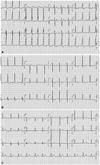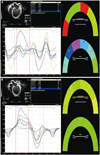Abstract
Preexcitation by accessory pathways (APs) is known to cause dyssynchrony of the ventricle, related to ventricular dysfunction. Correction of ventricular dyssynchrony can improve heart failure in cases of dilated cardiomyopathy (DCMP) with preexcitation. Here, we report the first case of a child with DCMP and Wolff-Parkinson-White (WPW) syndrome treated with amiodarone and radiofrequency catheter ablation (RFCA) in Korea. A 7-year-old boy, who suffered from DCMP and WPW syndrome, showed improved left ventricular function and clinical functional class after treatment with amiodarone to eliminate preexcitation. QRS duration and left ventricular ejection fraction (LVEF) were inversely correlated with amiodarone dosage. After confirming the reduction of preexcitation effects in DCMP, successful RFCA of the right anterior AP resulted in LVEF improvement, along with the disappearance of preexcitation. Our findings suggest that ventricular dyssynchrony, caused by preexcitation in DCMP with WPW syndrome, can worsen ventricular function and amiodarone, as well as RFCA, which should be considered as a treatment option, even in young children.
Wolff-Parkinson-White (WPW) syndrome is a preexcitation of the heart, caused by an accessory pathway (AP) that bypasses the atrioventricular node, and is associated with supraventricular tachycardia.1) Incessant or recurrent AP-mediated supraventricular tachycardia can cause dilated cardiomyopathy (DCMP).2)3) However, overt ventricular preexcitation in children can cause ventricular dysfunction, even in the absence of recurrent and incessant tachyarrhythmia. 4)5) Preexcitation by an AP is associated with decreased left ventricular function, depending on the location of the AP.5) Patients with a right-sided AP, with preexcitation, have more severe cardiac dysfunction.5-8) It is well known that in most patients, cardiac function improves and reverse remodeling initiates after preexcitation stops.6-8) The etiology of cardiac dysfunction should be evaluated for the appropriate treatment of DCMP with WPW syndrome. It is important to differentiate tachycardia-induced cardiomyopathy from idiopathic cardiomyopathy with coexisting WPW syndrome.
Here, we report the first case of a child with DCMP and WPW syndrome, treated with amiodarone and radiofrequency catheter ablation (RFCA) in Korea. The change in preexcitation in response to amiodarone can help evaluate its effect on the dyssynchrony of DCMP, and determine if RFCA should be used for children with DCMP and WPW syndrome.
A previously healthy 3-month-old boy was presented with an abnormal electrocardiography (ECG) at a routine check-up for a hydrocele operation. His body weight was 5.5 kg, and his cardiac examination was notable for a normal S1 and a grade II/VI regurgitant systolic murmur heard at the apex. At admission, overt ventricular preexcitation was noted on 12-lead ECG. The vector of the AP suggested a right-sided pathway. A chest X-ray showed severe cardiomegaly with increased pulmonary vascular markings. Echocardiography revealed paradoxical septal motion, severe mitral regurgitation and global hypokinesia with a 22.9% of left ventricle ejection fraction (LVEF, normal range: 55-65% at his age) and dilated left ventricle, with an end-diastolic dimension (LVEDD) of 54.6 mm (normal range: 22-28 mm at his age). Digoxin, captopril, diuretics, and carvedilol were given, but cardiac function remained poor.
At five of his age, supraventricular tachycardia developed. Based on poor LVEF and tachycardia, a trial of amiodarone was administered. After amiodarone treatment, a shortening of the QRS duration (130 ms vs. 117 ms) and delta wave disappearance were noted on ECG, with improved general condition.
There was significant improvement of LVEF (27% vs. 39%, normal range: 55-65% at his age) and reduction of LVEDD (58 mm vs. 52 mm, normal range 30-38 mm). However, reduction of amiodarone dosage brought the increase of the QRS duration (117 ms vs. 126 ms), with deterioration of the LVEF (Figs. 1A, B and 2). After confirming the effect of preexcitation on left ventricular function, RFCA of the right anterior AP was successfully performed, resulting in LVEF improvement (19% vs. 38%), reduction of LVEDD (58.3 mm vs. 54.6 mm), shortening of QRS duration (126 ms vs. 80 ms) and disappearance of preexcitation (Fig. 1C). Echocardiography also showed disappearance of left ventricle dyssynchrony (Fig. 3). The patient is doing well with gradual improvement of left ventricular function.
WPW syndrome is caused by an anomalous atrioventricular AP, and manifests as preexcitation on the surface ECG. Dyssynchronous ventricular depolarization occurs in WPW patients. Abnormalities of interventricular septal motion by preexcitation in WPW syndrome can result in global left ventricular dysfunction, mimicking idiopathic DCMP. Therefore, differentiating between tachycardia-induced cardiomyopathy and idiopathic cardiomyopathy with coexisting WPW syndrome is important. Although the pathogenic mechanism, underlying the development of DCMP in patients with WPW syndrome, is not clearly understood, suggestions are that 1) children with asymptomatic ventricular preexcitation are at risk of developing DCMP during follow-up, even in the absence of persistent and recurrent tachycardias; 2) after the disappearance of preexcitation, significant recovery of left ventricular function and reverse remodeling occurs, suggesting a causal relationship between ventricular preexcitationmediated dyssynchrony and the development of DCMP; and 3) left ventricular dyssynchrony may be more pronounced in the septal and paraseptal AP, compared with right free-wall and left-sided APs.5)7)9)10)
Interestingly, a significant improvement in left ventricular function occurred after successful catheter ablation of the AP, in our reported case. Preexcitation-mediated left ventricular dyssynchrony disturbs the myocardial regional workload and wall stress, which may result in wall motion abnormalities, myocardial perfusion defects, changes in coronary blood flow, adverse remodeling with progressive left ventricular dilation and asymmetrical changes in left ventricular wall thickness.11)12) In contrast to the right free wall pathways, a septal AP may cause preexcitation of a substantial part of the interventricular septum, inducing dyskinetic septal motion and significant left ventricular dyssynchrony.10) After a loss of preexcitation, RFCA, in particular, can result in mechanical resynchronization, reverse remodeling and improvement of left ventricular function.8)10) After RFCA, shortening of the anteroseptal to posterior wall delay was noted on echocardiography and synchronous contraction was demonstrated with beneficial reverse remodeling of the left ventricle in our case.
In this case, we first attempted pharmacologic suppression of preexcitation by amiodarone because of reported effect of amiodarone on ventricular dysfunction with preexcitation, as well as relatively high risk of RFCA complications in infants.13)14) Amiodarone showed the improvement of LV function with suppression of preexcitation. After confirming the detrimental effects of preexcitation on DCMP, RFCA of the right anterior AP was successfully performed, resulting in significant improvement in left ventricular dysfunction. Amiodarone can be considered as alternative short term treatment option for infants with DCMP and WPW syndrome, if too small infants for high risk of complications of RFCA. A change in preexcitation (QRS duration on ECG) in response to amiodarone helps to evaluate its effect on dyssynchrony of DCMP and to decide RFCA for children with DCMP and WPW syndrome. We prescribed amiodarone relatively late, at 5 years of his age, because of a relatively stable clinical state. However, we now consider early trial of amiodarone, in order to evaluate the effect of preexcitation on left ventricular function in DCMP with WPW syndrome. Regardless of the amount of amiodarone, which is effective for preexcitation suppression, RFCA should be considered in DCMP children with WPW syndrome at any age because those with overt ventricular preexcitation are at risk for developing DCMP in the absence of recurrent and incessant tachyarrhythmia. Regardless of the effectiveness of amiodarone or RFCA, preexcitation suppression can initiate reverse remodeling of a dyssynchronous left ventricle in DCMP with WPW syndrome.
Figures and Tables
Fig. 1
ECG with delta wave. ECG showed the change of delta wave before amiodarone (A) and after amiodarone (B). Delta wave disappeared after use of amiodarone. RFCA also showed successful elimination of delta wave (C). ECG: electrocardiography, RFCA: radiofrequency catheter ablation.

Fig. 2
The effect of amiodarone. Amiodarone shortened the QRS duration (QRSd) and improve the left ventricular function {LV ejection fraction (LVEF)}. According to the reduction of amiodarone dosage, preexcitation reappeared along with LVEF deterioration. Successful radiofrequency catheter ablation (RFCA) of the right anterior accessory pathway showed improvement of LV function.

Fig. 3
Time to peak longitudinal velocity images. Echocardiography demonstrated the change of time to peak longitudinal velocity images which are compatible with longitudinal dyssynchrony of the left ventricles before RFCA (A) and improved dyssynchrony after RFCA (B). RFCA: radiofrequency catheter ablation.

References
1. Campbell RM, Strieper MJ, Frias PA, Collins KK, Van Hare GF, Dubin AM. Survey of current practice of pediatric electrophysiologists for asymptomatic Wolff-Parkinson-White syndrome. Pediatrics. 2003. 111:e245–e247.
2. Schulze OC, Kammeraad J, Ramanna H, Sreeram N. Catheter ablation for tachyarrhythmia-induced cardiomyopathy in infants. Int J Cardiol. 2000. 74:99–100.
3. Umana E, Solares CA, Alpert MA. Tachycardia-induced cardiomyopathy. Am J Med. 2003. 114:51–55.
4. Niksch AL, Dubin AM. Risk stratification in the asymptomatic child with Wolff-Parkinson-White syndrome. Curr Opin Cardiol. 2006. 21:205–207.
5. Udink ten Cate FE, Kruessell MA, Wagner K, et al. Dilated cardiomyopathy in children with ventricular preexcitation: the location of the accessory pathway is predictive of this association. J Electrocardiol. 2010. 43:146–154.
6. Cadrin-Tourigny J, Fournier A, Andelfinger G, Khairy P. Severe left ventricular dysfunction in infants with ventricular preexcitation. Heart Rhythm. 2008. 5:1320–1322.
7. Emmel M, Balaji S, Sreeram N. Ventricular preexcitation associated with dilated cardiomyopathy: a causal relationship? Cardiol Young. 2004. 14:594–599.
8. Iwasaku T, Hirooka K, Taniguchi T, et al. Successful catheter ablation to accessory atrioventricular pathway as cardiac resynchronization therapy in a patient with dilated cardiomyopathy. Europace. 2009. 11:121–123.
9. Fazio G, Mongiovi' M, Sutera L, Novo G, Novo S, Pipitone S. Segmental dyskinesia in Wolff-Parkinson-White syndrome: a possible cause of dilatative cardiomyopathy. Int J Cardiol. 2008. 123:e31–e34.
10. Yamanaka S, Shirayama T, Inoue K, et al. Improved cardiac function after catheter ablation in a patient with type B Wolff-Parkinson-White syndrome with an old myocardial infarction. Jpn Circ J. 1998. 62:860–862.
11. Prinzen FW, Cheriex EC, Delhaas T, et al. Asymmetric thickness of the left ventricular wall resulting from asynchronous electric activation: a study in dogs with ventricular pacing and in patients with left bundle branch block. Am Heart J. 1995. 130:1045–1053.
12. Tantengco MV, Thomas RL, Karpawich PP. Left ventricular dysfunction after long-term right ventricular apical pacing in the young. J Am Coll Cardiol. 2001. 37:2093–2100.
13. Hirasawa Y, Nakagomi A, Kobayashi Y, Katoh T, Mizuno K. Short-term amiodarone treatment attenuates the production of monocyte cytokines and chemokines by C-reactive protein and improves cardiac function in patients with idiopathic dilated cardiomyopathy and ventricular tachycardia. Circ J. 2009. 73:639–646.
14. Deal BJ, Keane JF, Gillette PC, Garson A Jr. Wolff-Parkinson-White syndrome and supraventricular tachycardia during infancy: management and follow-up. J Am Coll Cardiol. 1985. 5:130–135.




 PDF
PDF ePub
ePub Citation
Citation Print
Print


 XML Download
XML Download